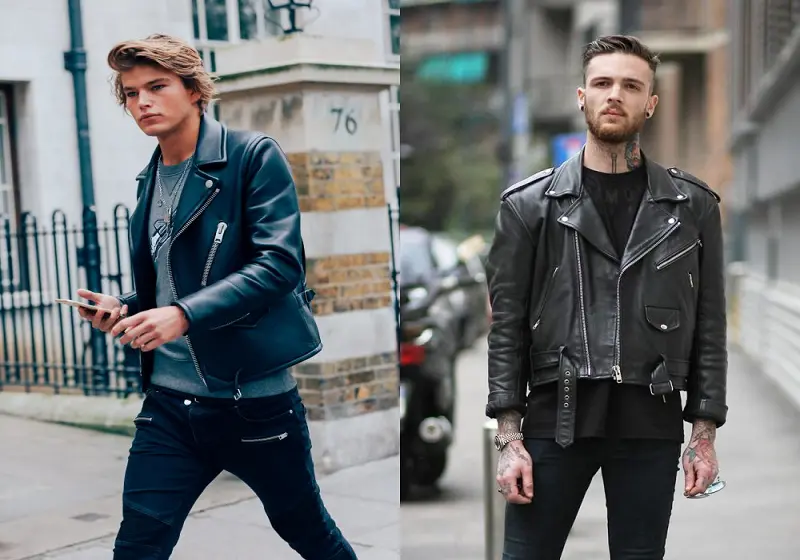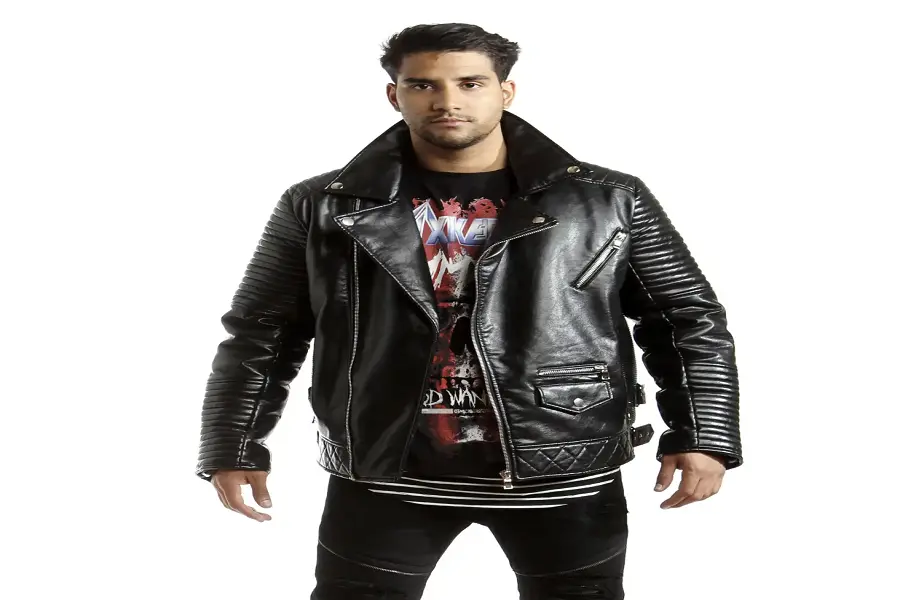Sustainable Style Meets Classic Edge (2024 Edition)
The iconic biker jacket has undergone a revolutionary transformation. The modern vegan leather biker jacket embodies the perfect fusion of ethical fashion and timeless rebellion.
Whether you’re a seasoned vegan fashion enthusiast or simply exploring sustainable alternatives, this comprehensive guide will walk you through everything you need to know about these innovative garments.
Reading time: 18 minutes
What Makes a Leather Jacket “Vegan”?
The term “vegan leather” has evolved significantly from its humble beginnings as simple plastic alternatives. Today’s vegan leather biker jackets showcase groundbreaking innovations in sustainable materials science and fashion technology.
The Evolution of Vegan Leather
Traditional leather production has long raised ethical and environmental concerns. The emergence of vegan alternatives wasn’t just about animal welfare – it represented a complete paradigm shift in how we approach fashion manufacturing.
Early attempts at vegan leather often fell short in both quality and sustainability. However, recent technological breakthroughs have transformed the industry, delivering options that often surpass traditional leather in both performance and environmental impact.
Modern Material Innovations
Revolutionary Plant-Based Materials:
- Piñatex
- Created from pineapple leaf fibers
- Uses agricultural waste products
- Requires minimal additional resources
- Supports farming communities
- Biodegradable at end-of-life
- Water-resistant properties
- Cork Leather
- Harvested sustainably from cork oak trees
- Naturally water-resistant
- Extremely durable
- Fire-resistant properties
- Antibacterial characteristics
- Renewable every 9 years
- Apple Leather
- Developed from apple industry waste
- Minimal environmental impact
- Soft, supple texture
- Excellent durability
- Lower carbon footprint
- Biodegradable components
- Mycelium Leather
- Grown from mushroom roots
- Carbon-negative production
- Customizable properties
- Natural water-resistance
- Biodegradable
- Rapidly renewable
- Cactus Leather
- Minimal water requirements
- Organic growing processes
- Highly sustainable
- Excellent durability
- Soft, premium feel
- Partially biodegradable
Comprehensive Material Comparison Table
| Material Type | Durability (1-5) | Breathability (1-5) | Water Resistance (1-5) | Cost Range | Environmental Impact | Maintenance Level |
| Piñatex | 4 | 3 | 4 | $$$$ | Very Low | Medium |
| Cork Leather | 4 | 5 | 5 | $$$$ | Minimal | Low |
| Apple Leather | 3 | 4 | 3 | $$$ | Low | Medium |
| Mycelium | 3 | 5 | 4 | $$$$ | Minimal | Low |
| Cactus Leather | 4 | 4 | 4 | $$$ | Very Low | Medium |
| Traditional PU | 2 | 2 | 3 | $ | High | High |
Quality Indicators and Construction
Essential Hardware Elements
The hardware on a vegan leather biker jacket plays a crucial role in both functionality and aesthetics. Look for:
Zippers:
- YKK or equivalent quality
- Smooth operation
- Metal construction
- Reinforced backing
- Double-stitched attachment
Snaps and Buttons:
- Rust-resistant materials
- Secure attachment
- Even spacing
- Reinforced backing
- Quality metal composition
Structural Elements:
- Double-stitched seams
- Reinforced stress points
- Quality lining materials
- Even stitching throughout
- Proper weight distribution
Weather Performance Features
Modern vegan leather biker jackets often incorporate advanced weather protection:
Water Resistance:
- Hydrophobic coatings
- Sealed seams
- Water-resistant zippers
- Protected vents
- Quick-drying properties
Temperature Regulation:
- Breathable membrane technology
- Moisture-wicking linings
- Ventilation systems
- Thermal regulation
- All-season adaptability
Style Guide & Versatility
Comprehensive Fit Guide
Shoulder Fit:
- Seams should align with natural shoulder edge
- No pulling across back
- Comfortable arm movement
- Even draping
- Proper proportion
Sleeve Length:
- Ends at wrist bone
- Allows for layering
- No bunching
- Even cuff alignment
- Proper articulation
Torso Fit:
- Comfortable zipping
- Room for light layer
- Natural waist alignment
- Even hem
- Proper proportion
Body Type Styling Guide
Athletic Build:
- Fitted silhouettes
- Defined waist
- Structured shoulders
- Horizontal details
- Cropped lengths
Broader Build:
- Vertical design elements
- Longer lengths
- Strategic seaming
- Dark colors
- Minimal hardware
Petite Frame:
- Cropped styles
- Minimal hardware
- Lighter materials
- Fitted silhouettes
- Vertical details
Top Sustainable Brands & Their Innovations
Leading Manufacturers
- Nanushka
- Price Range: $450-800
- Speciality: Premium cork-based leather
- Best For: Luxury everyday wear
- Native Shoes
- Price Range: $200-400
- Speciality: Recycled materials
- Best For: Weather-resistant options
- Will’s Vegan Shoes
- Price Range: $150-300
- Speciality: Bio-based materials
- Best For: Classic biker styles
Care & Maintenance
Essential Care Guide
Daily Care:
- Wipe down with a damp cloth
- Store on padded hangers
- Keep away from direct sunlight
- Use vegan leather conditioner quarterly
Deep Cleaning Steps:
- Test cleaning solution on a hidden area
- Use specialized vegan leather cleaner
- Apply with microfiber cloth
- Air dry away from heat sources
- Condition after cleaning
Making the Smart Purchase
Quality Indicators Checklist
✓ Even stitching throughout
✓ Smooth, consistent material texture
✓ Quality hardware with solid weight
✓ No chemical smell
✓ Clear material composition labeling
Red Flags to Watch For
❌ Inconsistent stitching
❌ Plastic-feeling hardware
❌ Strong chemical odor
❌ Unclear material sourcing
❌ Poor brand transparency
Environmental Impact
Carbon Footprint Comparison
Traditional leather production creates approximately 110 pounds of CO2 per jacket. In contrast, plant-based vegan leather options produce:
- Piñatex: 25 pounds CO2
- Cork leather: 18 pounds CO2
- Apple leather: 22 pounds CO2
Sustainability Case Study
Brand: Native Shoes Challenge: Creating a durable vegan leather biker jacket with zero waste Solution: Developed a closed-loop production system Result: 90% reduction in production waste and 100% recyclable product
Future Trends

The vegan leather biker jacket market is evolving rapidly. Watch for:
- Bio-fabricated materials
- Enhanced durability technologies
- Improved breathability solutions
- Zero-waste production methods
Quick Reference Guide
Size Conversion Chart
| US Size | EU Size | Chest (inches) | Sleeve Length |
| XS | 44 | 34-36 | 32 |
| S | 46 | 36-38 | 33 |
| M | 48 | 38-40 | 34 |
| L | 50 | 40-42 | 35 |
| XL | 52 | 42-44 | 36 |
Price Point Guide
- Entry Level: $100-200
- Mid-Range: $200-400
- Premium: $400-800
- Luxury: $800+
Conclusion
The vegan leather biker jacket represents more than just a fashion choice – it’s a statement about the future of sustainable style. With continuing innovations in materials and production methods, these jackets now offer durability, style, and environmental consciousness in one package.
When choosing your perfect vegan leather biker jacket, consider your specific needs, budget, and style preferences. Remember that investing in quality often pays off in longevity and satisfaction.
Looking to make your purchase? Check out our recommended brands above and remember to reference our quality indicators checklist before making your final decision.
Frequently Asked Questions About Vegan Leather Biker Jackets
Q: How durable are vegan leather biker jackets compared to traditional leather?
A: Modern vegan leather biker jackets can last 5-7 years with proper care. While traditional leather might last longer, the gap has narrowed significantly with new materials like Piñatex and cork leather showing excellent durability metrics.
Q: Can I ride a motorcycle while wearing a vegan leather jacket?
A: Yes, but choose jackets specifically designed for riding. Look for reinforced stitching, protective padding options, and materials rated for abrasion resistance. Brands like Naska and Black Arrow make vegan motorcycle jackets that meet safety standards.
Q: How do I remove stains from my vegan leather jacket?
A: Most stains can be removed with a gentle cleaner specifically formulated for vegan leather. Start with a spot test, then use a microfiber cloth to gently work the cleaner into the stain. Never use harsh chemicals or traditional leather cleaners.
Q: Why are some vegan leather jackets so expensive?
A: Premium vegan leather jackets often use innovative, sustainable materials that require specialized production processes. The cost reflects research development, eco-friendly manufacturing, fair labor practices, and quality construction.
Q: Do vegan leather jackets break in like traditional leather?
A: Yes, but differently. While traditional leather stretches and molds, vegan leather typically softens and becomes more flexible with wear. Most modern materials need minimal breaking in and maintain their shape better over time.

With over 9 years of dedicated experience in the automotive industry, I am passionate about all things automotive. My journey began with a deep curiosity for automobiles, which led me to delve deeper into their mechanics, technology and trends. My expertise spans various aspects of the automotive world, from the latest electric vehicles to classic car restoration techniques. Through my articles, I aim to share my knowledge and insights, helping readers stay informed and inspired in the fast-paced world of the automobile.












